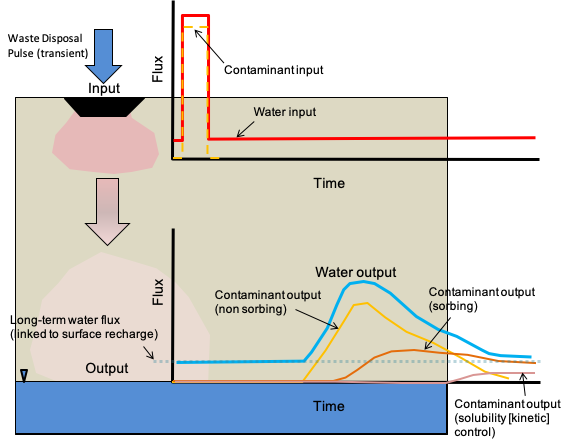Vadose Zone Performance Assessment for Inorganic Aqueous Waste Disposal Sites
Inorganic contaminants in aqueous waste solutions disposed at the land surface have the potential to contaminate groundwater. However, contaminant concentrations are attenuated during transport of the contaminants through the vadose zone. Quantifying contaminant attenuation and the resulting temporal profile of contaminant concentrations in underlying groundwater is important for assessing the need for and type of remediation in the vadose zone and groundwater. Contaminant transport through the vadose zone beneath aqueous waste disposal sites is affected by two types of attenuation processes: 1) attenuation caused by unsaturated flow, and 2) attenuation caused by biogeochemical reactions and/or physical/chemical interaction with sediments. Mixing processes with the groundwater are also important for estimating contaminant concentrations in groundwater resulting from vadose zone contaminant flux.

A structured approach using a mass-flux based framework was developed to evaluate transport and attenuation of contaminants through the vadose zone (Truex et al., 2015a; Truex and Carroll, 2013). The approach incorporates a set of numerical simulation results to provide quantitative information for estimating future contaminant flux to the groundwater based on site-specific conditions. The approach also provides guidance for conducting and presenting the evaluation of vadose zone contaminant transport in the context of the U.S. Environmental Protection Agency protocols for evaluating monitored natural attenuation. Collectively, these elements provide an effective approach for conducting an evaluation to support remedy decisions.
Two case studies have been conducted using this approach. One case study evaluated a perched water zone beneath the B, BX, and BY Tank Farms area of the Hanford Site where the perched water contains elevated concentrations of uranium and Tc-99 (Truex et al., 2013; Oostrom et al., 2013). Results from the evaluation of this dynamic system (with recharge, perched water extraction, and flux towards the groundwater) enabled implementation of effective monitoring of the progress of perched water removal and provided a means for estimating contaminant flux to groundwater in support of remedy decisions. The second case study examined the Hanford's SX Tank Farms to demonstrate how the approach can be applied to a complex subsurface and contaminant scenario (Truex et al., 2015b).
Cited References:
- Oostrom, M., M.J. Truex, K.C. Carroll, and G.B. Chronister. 2013. "Perched-water Analysis Related to Deep Vadose Zone Contaminant Transport and Impact to Groundwater." J. Hydrology, 505:228-239.
- Truex, M.J., and K.C. Carroll. 2013. "Remedy Evaluation Framework for Inorganic, Non-Volatile Contaminants in the Deep Vadose Zone." PNNL-21815, Pacific Northwest National Laboratory, Richland, Washington.
- Truex, M.J., M. Oostrom, K.C. Carroll, and G.B. Chronister. 2013. "Perched-Water Evaluation for the Deep Vadose Zone Beneath the B, BX, and BY Tank Farms Area of the Hanford Site." PNNL-22499, Pacific Northwest National Laboratory, Richland, Washington.
- Truex, M.J., M. Oostrom, and G.D. Tartakovsky. 2015a. "Evaluating Transport and Attenuation of Inorganic Contaminants in the Vadose Zone for Aqueous Waste Disposal Sites." PNNL-24731, Pacific Northwest National Laboratory, Richland, Washington.
- Truex, M.J., M. Oostrom, G.V. Last, C.E. Strickland, and G.D. Tartakovsky. 2015b. "Evaluating Contaminant Flux from the Vadose Zone to the Groundwater in the Hanford Central Plateau: SX Tank Farms Case Study." PNNL-23737, Pacific Northwest National Laboratory, Richland, Washington.